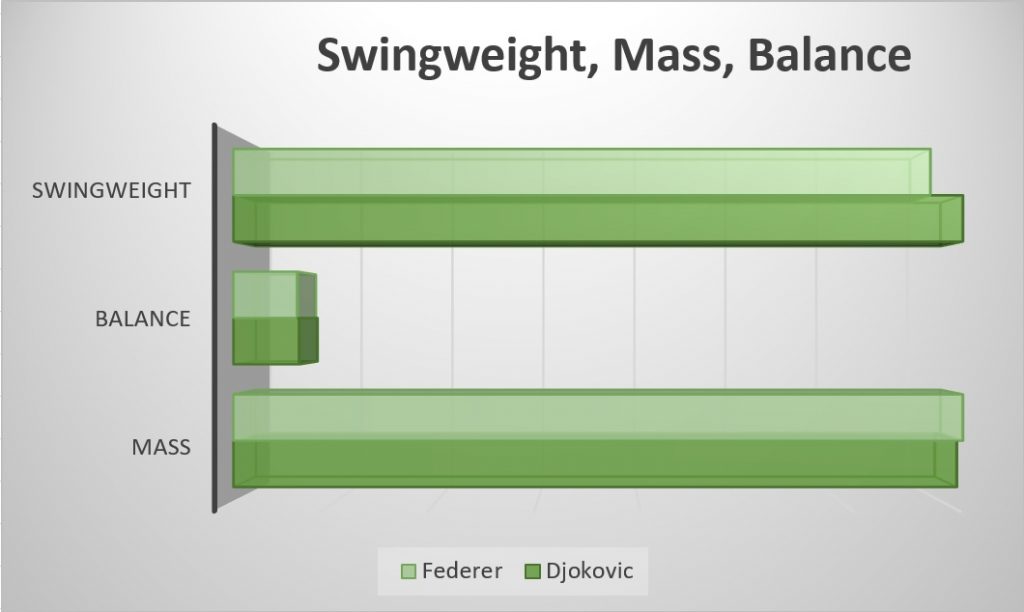Welcome back to another edition of the racket matchup analysis before a Grand Slam final. This time we have Roger Federer and Novak Djokovic going head to head on the lawn of the Wimbledon centre court.
I’ll compare their respective racket setups and explain what the rackets allow them to do differently, according to the IT theories. If you just want to know their specifications, check out our ATP Tour player’s racket specification database.


First, let’s compare the specifications on our grass themed charts here. Both use a high swingweight and high static weight rackets, for today’s standards, but that’s why they are in the finals. Djokovic with a higher swingweight, but less headlight balance, and more weight distributed in the head, resulting in a higher polarization index. That enables him to use a lighter static weight while still maintaining higher swingweight than Federer. The mentioned weight distribution also results in higher MGR/I for Federer.

So what does this mean for their matchup today? They both have their rackets set up extremely well to suit their game, perfectly in line with Impacting Tennis Theory on the essence of racket customization. The less headlight balance and higher swingweight means Djokovic has to use longer strokes to accelerate the racket through the contact. This pairs well with the fact that the courts at Wimbledon are slow this year, and he has plenty of time to set up his long strokes. Because of the more polarized setup, with a lower MGR/I, he can’t hit through the court as much a Federer can for example, but he can hit deep, heavy and penetrating shots. When he gets just a little more time on the ball, he »ties the ball on a string« and starts hitting deep in the corners with lot’s of spin and that’s what Federer needs to avoid. When this happens, Roger needs to get out of it as soon as possible with a down the line winner/aggressive shot or a short slice to get the point a totally different dynamic. But both of these options, I consider to be high risk, but necessary when Djokovic starts dictating like mentioned.
Federer’s set up is perfect for a one-handed backhand and especially his more opened eastern forehand grip. For more on why is this, read the IT theories. He is often talking about that if he could learn tennis again, he would use a two-handed backhand, but the result would be very different. The racket as it is now, it really isn’t set up well for a two-handed backhand at the same level as his 1 hander. The way his racket is set up now, he can’t be so consistently deep form the back of the court as Djokovic can, but that’s not really his game anyways. His racket allows him to redirect the pace a lot, especially on the return for example, he is just blocking the ball back a lot. Against Nadal, he was the most successful when he could cut corners and redirect Nadal’s heavy shots down the line or with short angles. This should also be the gameplan against Djokovic as in their game essence Nadal and Djokovic are very similar. Redirecting with shorter strokes, combined with slices, should be aimed to get Djokovic off balance and a step too short to hit a really penetrating ball, giving Federer time to take just one more step to set up his forehand.
The main difference on the forehand side between Djokovic and Federer is that when Federer has a bit more time to set up, he usually finishes the point right away or with a volley on the next shot, but for Djokovic is’ usually just the first shot to help him build the point. Federer has a higher ceiling with his racket set up on his forehand side.
The MGR/I difference and more headlight balance on Roger’s racket means his game is more Antifragile (good read) at least on a surface like grass. He is better in chaotic situations like volleys, half volleys, improvised shots, wrist shots, small »bunts« of the ball, off-balance shots, overheads, smashes and so on. He should be aiming to get into the kind of game state where both players are in a more chaotic state.
Predicting the outcome of the match based on the racket matchup analysis would be silly, as there are still human factors involved. But the aim is to give you a better understanding of how different racket setups pair up head to head on the court, and what it means for the game state and development of the game.
What do you think, who will be able to get the most magic out of their rackets and their respective games?
With havin so much content and articles do you ever run into any problems of plagorism or copyright infringement?
My website has a lot of unique content I’ve either written myself or outsourced but it looks
like a lot of it is popping it up all over the internet without my permission. Do
you know any solutions to help protect against content from being ripped off?
I’d genuinely appreciate it.
I don’t mind some of the re-posts, most of them link to the original article on my web-page or social accounts. I’m a big advocate for free flowing information and content. It’s not worth fighting over it. It’s best just to remind people that you would appreciate if they credit your site or something, that go on with a more defensive approach.
Might not be what you wanted to hear, but hope it helps.